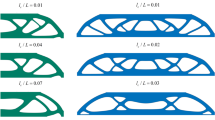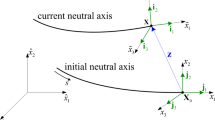Abstract
Aim of this work is the synthesis of auxetic structures using a topology optimization approach for micropolar (or Cosserat) materials. A distributed compliant mechanism design problem is formulated, adopting a SIMP–like model to approximate the constitutive parameters of 2D micropolar bodies. The robustness of the proposed approach is assessed through numerical examples concerning the optimal design of structures that can expand perpendicularly to an applied tensile stress. The influence of the material characteristic length on the optimal layouts is investigated. Depending on the inherent flexural stiffness of micropolar solids, truss–like solutions typical of Cauchy solids are replaced by curved beam–like material distributions. No homogenization technique is implemented, since the proposed design approach applies to elements made of microstructured material with prescribed properties and not to the material itself.










Similar content being viewed by others

References
Anderson WB, Lakes RS (1994) Size effects due to Cosserat elasticity and surface damage in closed-cell polymethacrylimide foam. J Mater Sci 29:6413–6419
Andreassen E, Lazarov BS, Sigmund O (2014) Design of manufacturable 3D extremal elastic microstructure. Mech Mater 69:1–10
Bendsøe MP, Kikuchi N (1988) Generating optimal topologies in structural design using a homogenization method. Comput Meth Appl Mech Eng 71:197–224
Bendsøe MP, Sigmund O (1999) Material interpolations in topology optimization. Arch Appl Mech 69:635–654
Bendsøe MP, Sigmund O (2003) Topology optimization - theory methods and applications. Springer, New York
Bigoni D, Drugan WJ (2006) Analytical derivation of cosserat moduli via homogenization of heterogeneous elastic materials. J Appl Mech 74(4):741–753
Bourdin B (2001) Filters in topology optimization. Int J Numer Methods Eng 50(9):2143–2158
Bruggi M, Taliercio A (2012) Maximization of the fundamental eigenfrequency of micropolar solids through topology optimization. Struct Multidiscip Optim 46(4):549–560
Bruns TE, Tortorelli DA (2001) Topology optimization of non–linear elastic structures and compliant mechanisms. Comput Meth Appl Mech Eng 190(26–27):3443–3459
Cadman J, Zhou S, Chen Y, Li Q (2012) On design of multi-functional microstructural materials. J Mater Sci 48:1–16
Coelho PG, Cardoso JB, Fernandes PR, Rodrigues HC (2011) Parallel computing techniques applied to the simultaneous design of structure and material. Adv Eng Software 42:219–227
Corigliano A, De Masi B, Frangi A, Comi C, Villa A, Marchi M (2004) Mechanical characterization of polysilicon through on-chip tensile tests. J Microelectromech Syst 13(2):200–219
de Borst R, Sluys LJ (1991) Localization in a Cosserat continuum under static and dynamic loading conditions. Comput Meth Appl Mech Eng 90:805–827
Deaton JD, Grandhi RV (2014) A survey of structural and multidisciplinary continuum topology optimization: post 2000. Struct Multidiscip Optim 49:1–38
Diaz A, Sigmund O (2010) A topology optimization method for design of negative permeability metamaterials. Struct Multidiscip Optim 41:163–177
Elipe JCA, Lantada AD (2012) Comparative study of auxetic geometries by means of computer-aided design and engineering. Smart Mater Struct 21:1–12
Eringen AC (1966) Linear theory of micropolar elasticity. J Math Mech 15:909–923
Evans KE, Alderson A (2000) Auxetic materials: functional materials and structures from lateral thinking!. Adv Mater 12(9):617–628
Fatemi J, Onck P R, Poort G, Van Keulen F (2003) Cosserat moduli of anisotropic cancellous bone: a micromechanical analysis. J Phys IV France 105:273–280
Forest S, Sab K (1998) Cosserat overall modeling of heterogeneous materials. Mech Res Commun 25 (4):449–454
Forest S, Barbe F, Cailletaud G (2000) Cosserat modelling of size effects in the mechanical behaviour of polycrystals and multi-phase materials. Int J Solids Struct 37(46-47):7105–7126
Gaspar N, Smith CW, Evans KE (2009) Auxetic behaviour and anisotropic heterogeneity. Acta Mater 57(3):875–880
Gauthier RD, Jahsman WE (1975) A quest for micropolar elastic constants. J Appl Mech ASME 42:369–374
Gei M, Rovati M, Veber D (2006) Effect of internal length scale on optimal topologies for Cosserat continua. In: Bendsøe MP et al. (eds) IUTAM symposium on topological design optimization of structures, machines and materials: status and perspectives, pp 157–166
Guest J, Prevost J, Belytschko T (2004) Achieving minimum length scale in topology optimization using nodal design variables and projection functions. Int J Numer Methods Eng 61(2):238–254
Koskinent J, Steinwall JE, Soave R, Johnson HH (1993) Microtensile testing of free-standing polysilicon fibers of various grain sizes. J Micromech Microeng 3:13–17
Lakes RS (1985) A pathological situation in micropolar elasticity. J Appl Mech 52:234–235
Lakes RS (1993) Strongly Cosserat elastic lattice and foam materials for enhanced toughness. Cell Polym 12 (17-30):157–166
Lakes RS (1995) Experimental methods for study of Cosserat elastic solids and other generalized elastic continua. In: Mühlhaus H (ed) Continuum models for materials with microstructure. J. Wiley, pp 1–25
Larsen UD, Sigmund O, Bouwstra S (1997) Design and fabrication of compliant micromechanisms and structures with negative poisson’s ratio. J Microelectromech Syst 6:99–105
Levy O, Krylov S, Goldfarb I (2006) Design considerations for negative Poisson ratio structures under large deflection for MEMS applications. Smart Mater Struct 15:1459–1466
Li X, Liu Q, Zhang J (2010) A micro-macro homogenization approach for discrete particle assembly -Cosserat continuum modeling of granular materials. Int J Solids Struct 47(2):291–303
Liu K, Tovar A (2014) An efficient 3D topology optimization code written in matlab. Struct Multidiscip Optim 50(6):1175– 1196
Liu S, Su W (2010) Topology optimization of couple-stress material structures. Struct Multidiscip Optim 40:319–327
Mariani S, Martini R, Ghisi A, Corigliano A, Beghi M (2011) Overall elastic properties of polysilicon films: a statistical investigation of the effects of polycrystal morphology. Int J Multiscale Com 9(3):327–346
Nishiwaki S, Frecker M I, Min S, Kikuchi N (1998) Topology optimization of compliant mechanisms using thehomogenization method. Int J Numer Meth Engng 42:535–559
Pedersen CBW, Buhl T, Sigmund O (2001) Topology synthesis of large-displacement compliant mechanisms. Int J Numer Meth Engng 50:2683–2705
Providas E, Kattis MA (2002) Finite element method in plane Cosserat elasticity. Comput Struct 80:2059–2069
Rovati M, Veber D (2007) Optimal topologies for micropolar solids. Struct Multidiscip Optim 33:47–59
Sharbati E, Naghdabadi R (2006) Computational aspects of the Cosserat finite element analysis of localization phenomena. Comput Mat Science 38:303–315
Sigmund O (1994) Materials with prescribed constitutive parameters: an inverse homogenization problem. Int J Solids Struct 31(17):2313–2329
Sigmund O (1997) On the design of compliant mechanisms using topology optimization. Mech Struct and Mach 25:493–524
Sigmund O (2000) A new class of extremal composites. J Mechan Ph Solids 48:397–428
Sigmund O (2007) Morphology-based black and white filters for topology optimization. Struct Multidiscip Optim 33(4):401–424
Sigmund O, Torquato S (1999) Design of smart composite materials using topology optimization. Smart Mater Struct 8:365– 379
Su W, Liu S (2015) Topology design for maximization of fundamental frequency of couple-stress continuum. Struct Multidiscip Optim 53(3):395–408
Svanberg K (1987) Method of moving asymptotes–a new method for structural optimization. Int J Numer Methods Eng 24:359– 373
Veber D, Taliercio A (2011) Topology optimization of three-dimensional non-centrosymmetric micropolar bodies. Struct Multidiscip Optim 45(4):575–587
Wang F, Lazarov BS, Sigmund O (2011) On projection methods, convergence and robust formulations in topology optimization. Struct Mutltidiscip Opt 43(6):767–784
Xia L, Li Z-M, Breitkopf P (2015) Design of materials using topology optimization and energy-based homogenization approach in Matlab. Struct Multidisc Optim 52:1229–1241
Yang W, Li Z-M, Shi W, Xie B-H, Yang M-B (2004) Review on auxetic materials. J of Mater Science 39:3269–3279
Yuan X, Tomita Y (2001) Effective properties of Cosserat composites with periodic microstructure. Mech Res Commun 28(3):265– 270
Author information
Authors and Affiliations
Corresponding author
Rights and permissions
About this article
Cite this article
Bruggi, M., Zega, V. & Corigliano, A. Synthesis of auxetic structures using optimization of compliant mechanisms and a micropolar material model. Struct Multidisc Optim 55, 1–12 (2017). https://doi.org/10.1007/s00158-016-1589-9
Received:
Revised:
Accepted:
Published:
Issue Date:
DOI: https://doi.org/10.1007/s00158-016-1589-9



